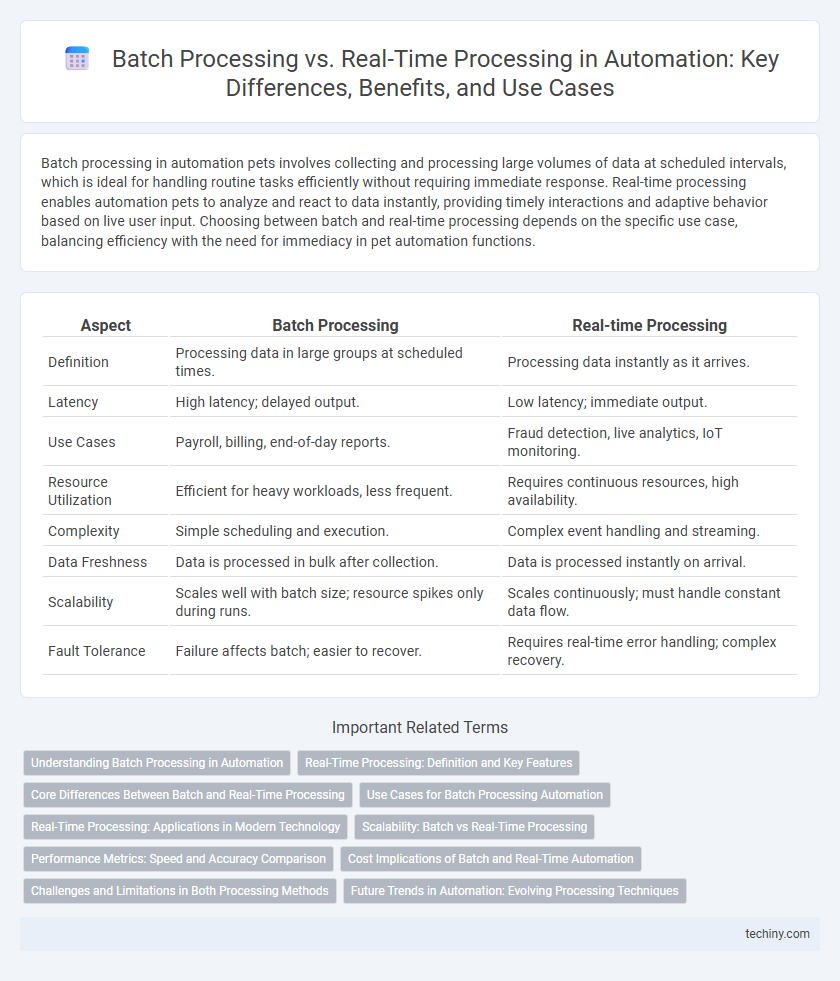Batch processing in automation pets involves collecting and processing large volumes of data at scheduled intervals, which is ideal for handling routine tasks efficiently without requiring immediate response. Real-time processing enables automation pets to analyze and react to data instantly, providing timely interactions and adaptive behavior based on live user input. Choosing between batch and real-time processing depends on the specific use case, balancing efficiency with the need for immediacy in pet automation functions.
Table of Comparison
| Aspect | Batch Processing | Real-time Processing |
|---|---|---|
| Definition | Processing data in large groups at scheduled times. | Processing data instantly as it arrives. |
| Latency | High latency; delayed output. | Low latency; immediate output. |
| Use Cases | Payroll, billing, end-of-day reports. | Fraud detection, live analytics, IoT monitoring. |
| Resource Utilization | Efficient for heavy workloads, less frequent. | Requires continuous resources, high availability. |
| Complexity | Simple scheduling and execution. | Complex event handling and streaming. |
| Data Freshness | Data is processed in bulk after collection. | Data is processed instantly on arrival. |
| Scalability | Scales well with batch size; resource spikes only during runs. | Scales continuously; must handle constant data flow. |
| Fault Tolerance | Failure affects batch; easier to recover. | Requires real-time error handling; complex recovery. |
Understanding Batch Processing in Automation
Batch processing in automation involves executing a group of tasks collectively at scheduled intervals, optimizing system efficiency by reducing overhead and resource contention. It is ideal for processing large volumes of data where real-time decision-making is unnecessary, enabling cost-effective and reliable workflows in industries like finance, manufacturing, and data analytics. Key benefits include improved throughput, error handling, and resource management compared to continuous data processing systems.
Real-Time Processing: Definition and Key Features
Real-time processing refers to the immediate capture, processing, and output of data as events occur, enabling instant decision-making and response. Key features include low latency, continuous data input handling, and high system reliability to support time-sensitive applications such as financial trading, industrial automation, and online customer interactions. This approach contrasts with batch processing, which handles data in large, scheduled groups rather than continuous streams.
Core Differences Between Batch and Real-Time Processing
Batch processing handles large volumes of data collected over time and executes tasks in scheduled groups, optimizing resource utilization and minimizing latency tolerance. Real-time processing processes data instantly as it arrives, enabling immediate decision-making and response critical for applications like fraud detection or autonomous systems. The core difference lies in latency and processing approach: batch prioritizes high throughput with delayed output, whereas real-time demands minimal latency with continuous data handling.
Use Cases for Batch Processing Automation
Batch processing automation excels in scenarios involving large volumes of data that do not require immediate analysis, such as payroll systems, end-of-day financial reconciliations, and bulk data imports. Industries like banking, retail, and telecommunications leverage batch automation for tasks such as transaction grouping, billing cycles, and data archival, enabling efficient resource use and minimizing system load during peak hours. This method ensures consistent and error-free processing by automating repetitive workflows that operate on scheduled intervals, significantly reducing manual intervention and operational costs.
Real-Time Processing: Applications in Modern Technology
Real-time processing powers critical applications in industries like finance, healthcare, and telecommunications, enabling instant data analysis and decision-making. This approach supports automated trading systems, remote patient monitoring, and live communication services by processing streaming data with minimal latency. The ability to handle continuous input and generate immediate output enhances operational efficiency and user experience in modern technology ecosystems.
Scalability: Batch vs Real-Time Processing
Batch processing scales efficiently by handling large volumes of data in scheduled intervals, minimizing resource contention and optimizing throughput for massive datasets. Real-time processing demands scalable infrastructure capable of low-latency data ingestion and processing, leveraging technologies like stream processing frameworks to accommodate fluctuating data streams. Choosing between batch and real-time scalability depends on workload characteristics, latency requirements, and infrastructure cost considerations.
Performance Metrics: Speed and Accuracy Comparison
Batch processing excels in handling large volumes of data with high accuracy by processing tasks in scheduled intervals, optimizing resource utilization but introducing latency. Real-time processing prioritizes immediate data handling, delivering superior speed for time-sensitive applications while maintaining acceptable accuracy through continuous data analysis. Performance metrics indicate batch processing achieves higher throughput with delayed output, whereas real-time processing ensures rapid response times critical for dynamic decision-making environments.
Cost Implications of Batch and Real-Time Automation
Batch processing automation typically reduces costs by grouping tasks and minimizing resource usage during off-peak hours, leading to lower infrastructure and maintenance expenses. Real-time processing demands continuous data handling and higher computational power, often increasing operational costs due to the need for advanced hardware and real-time software licenses. Choosing between batch and real-time automation depends on a balance between cost efficiency and the urgency of data processing requirements.
Challenges and Limitations in Both Processing Methods
Batch processing faces challenges such as latency issues and inflexibility in handling time-sensitive data, making it less suitable for scenarios requiring immediate insights. Real-time processing contends with limitations including high computational costs, complex infrastructure, and difficulties in ensuring data accuracy under rapid processing demands. Both methods require tailored optimization strategies to balance performance, cost, and application-specific requirements in automation workflows.
Future Trends in Automation: Evolving Processing Techniques
Future trends in automation reveal a shift from traditional batch processing towards real-time processing, driven by the need for instantaneous data analysis and decision-making in smart manufacturing and IoT environments. Advances in edge computing and AI integration enhance real-time processing capabilities, enabling systems to respond dynamically to changing conditions and optimize performance continuously. This evolution supports predictive maintenance, adaptive control systems, and improved operational efficiency, positioning real-time processing as a cornerstone of next-generation automated workflows.
Batch Processing vs Real-time Processing Infographic

 techiny.com
techiny.com